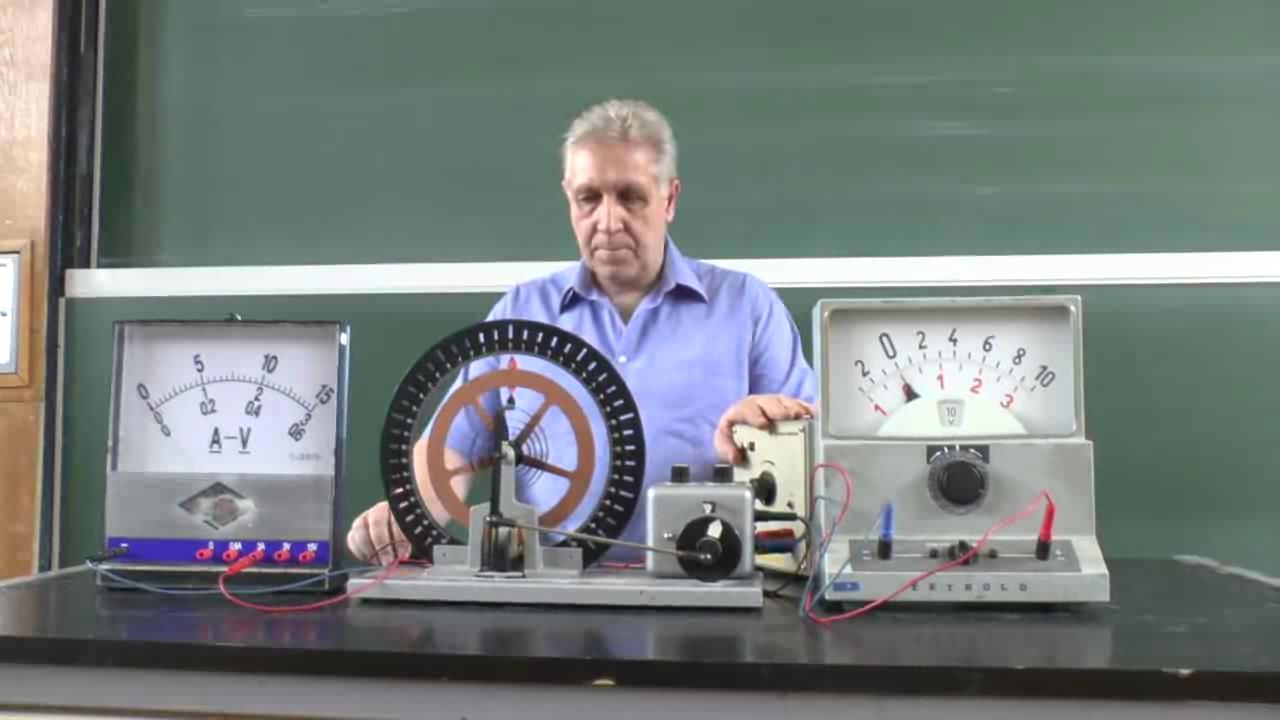„Kényszerrezgés II.” változatai közötti eltérés
(Új oldal, tartalma: „Kategória:Szerkesztő:Hartlein <wikitex> thumbtime=0:30 == Az elhangzó szöveg == szöveg == angol név == angol szöveg…”) |
|||
| (egy szerkesztő 5 közbeeső változata nincs mutatva) | |||
| 1. sor: | 1. sor: | ||
[[Kategória:Szerkesztő:Hartlein]] | [[Kategória:Szerkesztő:Hartlein]] | ||
<wikitex> | <wikitex> | ||
| − | [[ | + | [[Fájl:rot_kenyszer_rezges.ogv|thumbtime=0:30|bélyegkép|720px|[[Kényszerrezgés II.]]]] |
== Az elhangzó szöveg == | == Az elhangzó szöveg == | ||
| − | + | A [http://en.wikipedia.org/wiki/Robert_Pohl Pohl]-féle torziós inga korongjának torziós lengéseit fogjuk tanulmányozni. A baloldali mérőműszer kitérése a csillapítással arányos értéket fok mutatni, míg a jobboldali a mechanikus gerjesztés frekvenciájáról tájékoztat. A motor excenter segítségével állandó amplitúdójú, a fordulatszámnak megfelelő frekvenciájú rezgésre kényszeríti a spirálrugó végére erősített korongot. Vizsgáljuk meg a korong lengéseinek amplitúdóját folyamatosan növekvő frekvenciájú kényszer hatására. A növekvő frekvencia kezdetben növekvő amplitúdójú rezgést eredményez. Egy meghatározott frekvenciánál az amplitúdó példátlan mértékben megnő, a rendszer rezonanciáját figyelhetjük meg. Tovább növelve a frekvenciát a kényszerrezgés amplitúdója csökken. | |
| − | == | + | == Forced Oscillation II. == |
| − | + | Let us examine the oscillations of Pohl’s pendulum. The left meter shows a value proportional to the damping, while the right meter shows a value proportional to the driving force. With the help of the eccentric motor, we can force the wheel into an oscillation with constant amplitude and frequency corresponding to the rev. Let us observe the amplitude of the wheel’s swings as we increase the frequency of the driving force. The increasing frequency at first causes an increased amplitude. At a certain frequency, the amplitude increases incredibly quickly. This is the resonance frequency. If we continue to increase the frequency, the driven oscillation’s amplitude will decrease. | |
</wikitex> | </wikitex> | ||
A lap jelenlegi, 2014. március 9., 12:29-kori változata
Az elhangzó szöveg
A Pohl-féle torziós inga korongjának torziós lengéseit fogjuk tanulmányozni. A baloldali mérőműszer kitérése a csillapítással arányos értéket fok mutatni, míg a jobboldali a mechanikus gerjesztés frekvenciájáról tájékoztat. A motor excenter segítségével állandó amplitúdójú, a fordulatszámnak megfelelő frekvenciájú rezgésre kényszeríti a spirálrugó végére erősített korongot. Vizsgáljuk meg a korong lengéseinek amplitúdóját folyamatosan növekvő frekvenciájú kényszer hatására. A növekvő frekvencia kezdetben növekvő amplitúdójú rezgést eredményez. Egy meghatározott frekvenciánál az amplitúdó példátlan mértékben megnő, a rendszer rezonanciáját figyelhetjük meg. Tovább növelve a frekvenciát a kényszerrezgés amplitúdója csökken.
Forced Oscillation II.
Let us examine the oscillations of Pohl’s pendulum. The left meter shows a value proportional to the damping, while the right meter shows a value proportional to the driving force. With the help of the eccentric motor, we can force the wheel into an oscillation with constant amplitude and frequency corresponding to the rev. Let us observe the amplitude of the wheel’s swings as we increase the frequency of the driving force. The increasing frequency at first causes an increased amplitude. At a certain frequency, the amplitude increases incredibly quickly. This is the resonance frequency. If we continue to increase the frequency, the driven oscillation’s amplitude will decrease.
